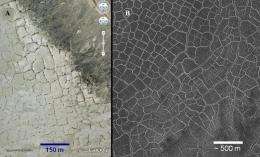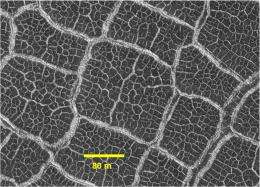Patterns in Mars crater floors give picture of drying lakes

Networks of giant polygonal troughs etched across crater basins on Mars have been identified as desiccation cracks caused by evaporating lakes, providing further evidence of a warmer, wetter martian past. The findings were presented today at the European Planetary Science Congress by PhD student Mr M Ramy El Maarry of the Max Planck Institute for Solar System Research.
The polygons are formed when long cracks in the surface of the martian soil intersect. El Marry investigated networks of cracks inside 266 impact basins across the surface of Mars and observed polygons reaching up to 250 metres in diameter. Polygonal troughs have been imaged by several recent missions but, until now, they have been attributed to thermal contractions in the martian permafrost. El Maarry created an analytical model to determine the depth and spacing of cracks caused by stresses building up through cooling in the martian soil. He found that polygons caused by thermal contraction could have a maximum diameter of only about 65 metres, much smaller than the troughs he was seeing in the craters.
“I got excited when I saw that the crater floor polygons seemed to be too large to be caused by thermal processes. I also saw that they resembled the desiccation cracks that we see on Earth in dried up lakes. These are the same type of patterns you see when mud dries out in your back yard, but the stresses that build up when liquids evaporate can cause deep cracks and polygons on the scale I was seeing in the craters,” said El Maarry.

El Maarry identified the crater floor polygons using images taken by the MOC camera on Mars Global Surveyor and the HiRISE and Context cameras on Mars Reconnaissance Orbiter. The polygons in El Maarry’s survey had an average diameter of between 70 and 140 metres, with the width of the actual cracks ranging between 1 and 10 metres.
Evidence suggests that between 4.6 and 3.8 billion years ago, Mars was covered in significant amounts of water. Rain and river water would have collected inside impact crater basins, creating lakes that may have existed for several thousand years before drying out. However, El Maarry believes that, in the northern hemisphere, some of the crater floor polygons could have been formed much more recently.
“When a meteorite impacts with the martian surface, the heat can melt ice trapped beneath the martian crust and create what we call a hydrothermal system. Liquid water can fill the crater to form a lake, covered in a thick layer of ice. Even under current climatic conditions, this may take many thousands of years to disappear, finally resulting in the desiccation patterns,” said El Maarry.
Source: Europlanet



















